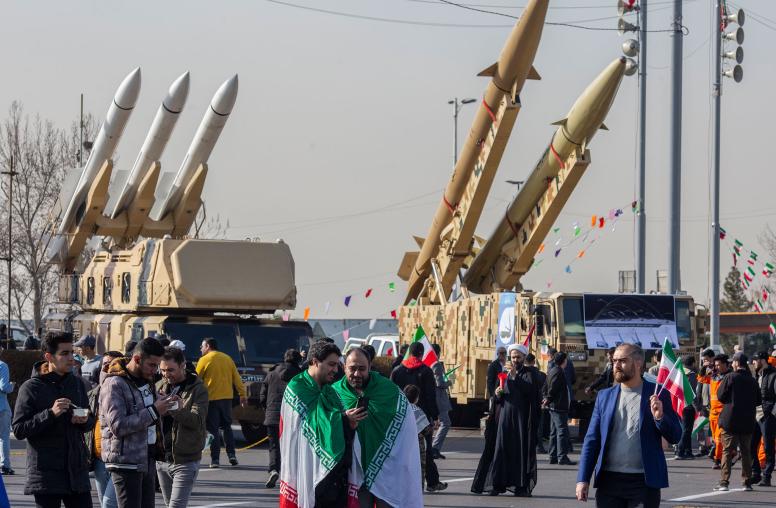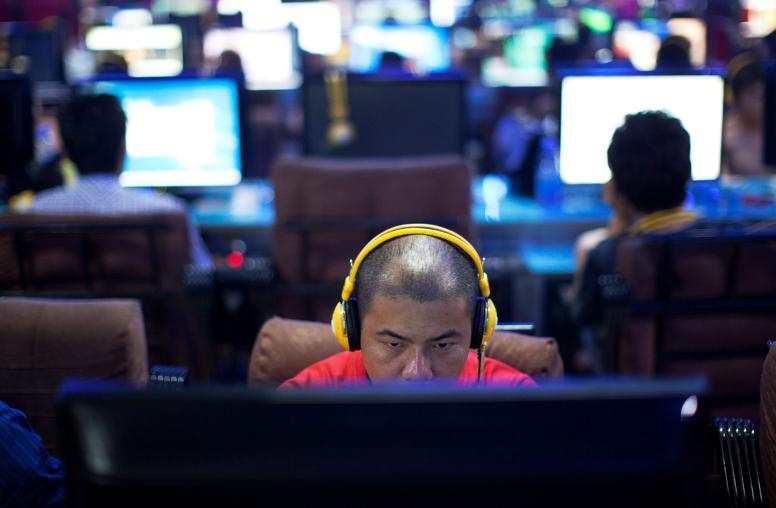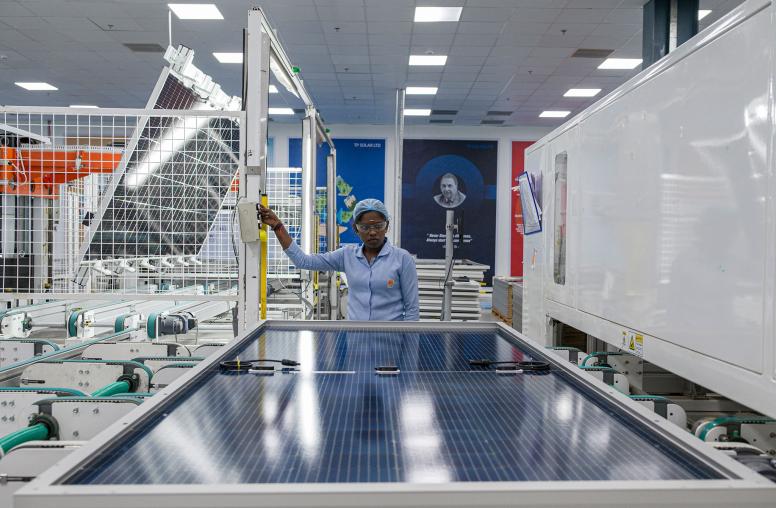After Beijing’s Balloon, What’s Next for U.S.-China Ties?
Amid a low point in the relationship, the balloon incident injects more mistrust and damages the opportunity to resume regular dialogue.
Days before U.S. Secretary of State Antony Blinken was set to travel to Beijing, the Pentagon announced it had detected a Chinese “surveillance balloon” over Montana. The incident sparked intense speculation about China’s intentions, including why it would choose to employ a relatively low-tech surveillance device. Ultimately, Blinken announced on February 3 that he was postponing his trip, which would have been the first by a U.S. secretary of state in five years. With U.S.-China tensions already simmering, the balloon episode injects more mistrust and scuttled the opportunity presented by Blinken’s trip to resume cooperation on areas of mutual interest and demonstrate that both sides want to better manage bilateral tensions.

USIP’s Rosie Levine and Carla Freeman look at what we know about the incident, how to make sense of China’s intentions and what’s in store for U.S.-China relations now.
What do we know so far about the balloon incident?
Levine: On February 2, the U.S. Department of Defense announced that it had detected a “high-altitude surveillance balloon” in the skies above Montana launched by China. The balloon had entered U.S. airspace a few days prior, making its way across Alaska and eventually settling above Montana, home to many of the United States’ nuclear missile facilities. On Friday, Chinese officials released a statement that indicated “regret” about the balloon, and in doing so, claimed ownership, but noted that the “mainly meteorological” balloon had floated into U.S. airspace by accident due to high winds.
On Saturday, the U.S. Air Force shot down the balloon off the coast of South Carolina and, at the time of publication, the recovery team is still working to interpret the “payload” the balloon was carrying. The Pentagon has noted this is not the first time this type of balloon has crossed into U.S. air space, and in recent days similar balloons have been spotted in Latin America, also confirmed to be Chinese. Subsequent reporting points to the balloon as part of a broader, global intelligence gathering operation that has been running for several years with balloons sighted over five continents.
In response to the balloon’s presence in U.S. airspace, U.S. Secretary of State Antony Blinken canceled a planned trip to Beijing, the first visit by a top U.S. diplomat in five years. While few expected significant breakthroughs in this meeting, travel by the secretary of state to China was a key outcome of the Biden-Xi meeting in November and would have provided Blinken with a chance not only to meet with China’s most senior diplomats but reportedly also with China’s top leader, General-Secretary Xi Jinping. It’s unclear what the balloon incident will mean for planned visits to China by U.S. Treasury Secretary Janet Yellen and Secretary of Defense Lloyd Austin.
How can we make sense of China’s intentions?
Freeman: Given the priority assigned to Blinken’s visit, its disruption by a balloon intrusion into U.S. airspace is perplexing. The balloon was clearly visible from the ground so its detection by U.S. authorities was highly likely, and with the balloon’s trajectory over multiple sensitive U.S. military sites, it’s no surprise that U.S. officials responded as they did.
Until the balloon’s payload is analyzed, it’s unclear what type of data or information it was able to collect during its cross-country flight but, according to a Pentagon official, the intelligence gathered by the balloon most likely has “limited additive value from an intelligence collective collection perspective." China has sophisticated satellites capable of collecting data on U.S. military installations. Balloons do have some advantages, including the ability to spend longer periods of time over specific areas than satellites; they are also relatively inexpensive. Information gathered before the balloon was downed point to its likely ability to capture emissions and signals to sharpen its understanding of U.S. radar and other systems.
For Beijing, the political, diplomatic and even reputational costs of this incident are high, raising questions about why China’s top leader would have gambled the chance to lower tensions with the United States for low-value intelligence.
There are many potential explanations: the balloon could have simply gone astray as Chinese officials purported, or it could be seen as a symbolic intrusion into U.S. airspace as a tit-for-tat response to visits by U.S. officials to Taiwan, which China claims as its sovereign territory. Some speculate, albeit without substantiation, that it could even reflect a challenge by some in the Chinese political system to disrupt U.S.-China diplomacy.
However, it is more likely that the balloon’s presence over the United States in the days ahead of Blinken’s visit is a symptom of coordination problems within the Chinese political system. The balloon appears to be linked to China’s Strategic Support Force (SSF), responsible for strategic space, cyber and electronic warfare missions for China’s military. Some reports suggest the SSF has a program to position reconnaissance balloons to conduct continuous surveillance at fixed points — a function satellites cannot perform. Notably, exemplifying China’s military-civil fusion policies, private-sector entities are responsible for operating the balloons. As the head of China’s military, Xi would have approved the program. However, once approved, the program would have moved ahead on a schedule set by the SSF.
This coordination problem is not unusual in the Chinese system, often described by political scientists as “fragmented authoritarianism.” In 2011, China’s military tested a stealth fighter during then Secretary of Defense Robert M. Gates’ visit to China, apparently to the surprise of civilian authorities. However, it suggests that despite the concentration of decision-making authority in China that has been a feature of Xi’s centralizing reforms since he took power a decade ago, coordination challenges remain.
Blinken’s trip to Beijing was never meant to be a total reset in relations but could have been part of a confidence-building process steering relations to a more manageable position. With a lack of regular communication and dialogue, the balloon incident risks further destabilizing an already tense situation. Above all, this latest development reveals how fragile bilateral ties remain.
Where do U.S.-China relations go from here?
Levine: This incident demonstrates that mistrust between the United States and China is likely here to stay. The relatively conciliatory tone in the lead-up to Blinken’s visit does not outweigh the United States’ signals of deep mistrust toward China’s intentions on issues large and small.
Even on the eve of Blinken’s visit, the United States struck a deal with the Philippines to establish four new military bases. These bases are well-positioned to monitor Chinese military operations in the South China Sea and the waters around Taiwan. Beyond the Pacific, China’s refusal to condemn Russia’s invasion of Ukraine has cast a long shadow over the prospect of meaningful cooperation.
The United States also continues to combat China in key aspects of the technology supply chain, from the CHIPS act to new restrictions on American companies exporting to Huawei. China’s domestic practices are also sticking points in the relationship — its crackdown on democratic freedoms in Hong Kong, hardline campaigns against the Uyghurs and other ethnic minorities, and the Chinese Communist Party’s claims of sovereignty over Taiwan and repeated attempts to push the boundaries and norms around the contested Island.
If mutual mistrust is here to stay, how is this dynamic best managed? U.S. and Chinese leadership may not get along but establishing how the two countries choose to handle their disagreements will define the next phase of the relationship. Significantly, Blinken’s visit to China has been postponed, not canceled. A rescheduled visit could serve as an important symbol that diplomatic channels are still a viable way for the two superpowers to voice their disagreements. This symbol would be even more powerful upon the backdrop of recent reports that states China’s defense minister, Wei Fenghe, rebuffed Secretary of Defense Lloyd Austin’s request to talk after the U.S. downed the balloon.
Although the balloon incident was certainly one of the more unexpected crises the U.S.-China relations have faced in recent years, crises are not unfamiliar to the two sides. As recently as December 2022, a Chinese fighter jet came within 20 feet of a US Air Force RC-135 aircraft over the South China Sea. Close calls have been more frequent in the South China Seas, and the question remains: If a serious crisis were to occur, could the United States and China work productively to solve it?
Despite these deep-seated issues, China and the United States remain dependent on each other. Trade between the United States and China in 2022 is expected to come in at an all-time high, despite the rhetoric in both countries emphasizing decoupling the two economies.
It is not just the bilateral relationship at stake. The United States’ allies and partners, especially those in Asia, have emphasized that the two major powers should establish productive ways to manage their differences. Although countries such as Japan, Vietnam and the Philippines have their own issues with China (ranging from military to political to economic concerns), they do not want to be the battleground for U.S.-China competition, nor be forced to choose a side outright.
For now, rhetoric and actions on both sides demonstrate that neither Washington nor Beijing will be seeking bonhomie any time soon. During his State of the Union address this week, President Biden said “winning the competition with China should unite all of us” and reiterated that China had violated U.S. sovereignty. Meanwhile, China’s Defense Ministry spokesperson Tan Kefei responded to the balloon incident by stating the United States has overreacted and China “reserves the right to use necessary means to deal with similar situations.”
Rescheduling Blinken’s visit will hardly repair the relationship between the United States and China. But, in an era of mutual mistrust, it would demonstrate to the world that diplomacy can and will be used to manage the bilateral relationship responsibly. A rescheduled visit would also provide an opportunity for America to rethink how it can use all the tools in our toolkit, including diplomacy, to manage our relationship with China before the next crisis occurs.



